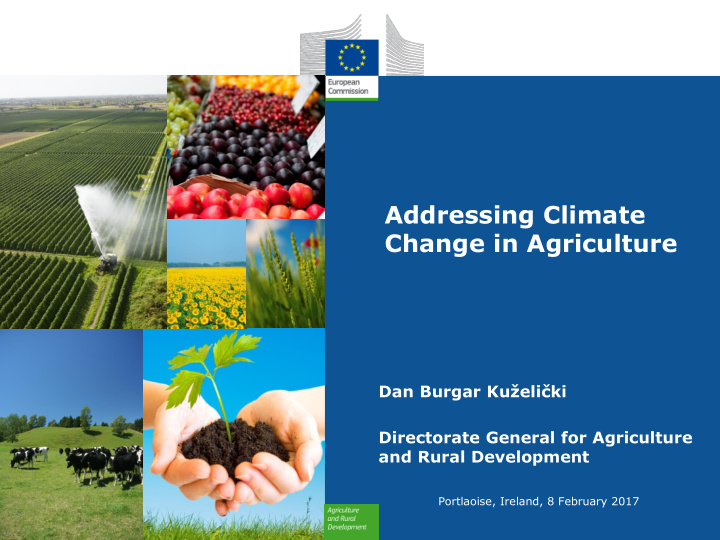



Addressing Climate Change in Agriculture Dan Burgar Kuželički Directorate General for Agriculture and Rural Development Portlaoise, Ireland, 8 February 2017
Where do we come from …
Paris Agreement • Global commitment to transition to a low- emission economy, holding the increase in the global temperature to well below 2 C • Highlights need to harness the potential of land use to contribute to global GHG mitigation efforts • Acknowledgement of the importance of food security • Entered into force 4 November 2016
European Council Conclusions on agriculture: • Acknowledge the lower mitigation potential of agriculture and land use sector • Their multiple objectives • The need to ensure coherence between the EU's food security and climate change objectives • Encouraging sustainable intensification of food production, while optimising the sector's contribution to GHG mitigation and sequestration , also through afforestation
2030 Climate and Energy Framework -40 % Greenhouse Gas Emissions (domestic EU) Non-ETS -30% Land Use, Land Effort Sharing use change and Regulation Forestry -30 % "No-Debit" Non-CO2 emissions Full Afforestation from Agriculture flexibility Buildings Deforestation Transport ETS Managed grasslands Max 280 Waste -43 % MtCO2eq Managed croplands F-gases Including: Max 100 Managed forest Power/Energy MtCO2eq Other small sectors Sector and Industry, Aviation outside ETS
Agriculture emissions
Reduction of non-CO 2 in agriculture is possible, but we need to consider that: • With no change in policy GHG decrease is slight - 2.3% • The costs: Total subsidies needed to reduce negative consequences are considerable (12.7-15.6 bio. Euro) • Without financial support, there will be negative consequences: • On production - e.g. changes in beef herd size can vary from -6.6% to -16% in the EU-28 • Emission leakage Limited mitigation potential of the sector Support is needed to avoid serious negative effects
Larger production effects with no subsidies Beef supply: %-change vs. the baseline (2030 ) 20% emission 20% emission target, target, no subsidies 80% subsidies
EcAMPA 2 shows how mitigation technologies contribute to the overall emission reduction target * The mitigation effects linked to genetic improvement measures cannot be analysed in isolation and are added to mitigation achieved by changes in Source: EcAMPA2 report (2016) production.
How to achieve multiple objectives Common Agricultural Policy cross-compliance mechanism • 'green payment' • Rural Development Programs • Irish RDP: - Priority 4+5 Other Priorities, (608 M€) - Almost 244 million EUR is allocated to climate- related issues Priority 5 (439 M€) - Investments into energy efficiency Priority 4 (2 873 M€) - Supporting climate-friendly agricultural P4+P5 84,4 practices % - Carbon conservation and sequestration Horizon 2020 • European Innovation Partnership for Agricultural Productivity and • Sustainability (EIP-AGRI)
Way forward … Future CAP Public consultation on Modernisation and simplification of the Common Agricultural Policy post 2020 https://ec.europa.eu/agriculture/consultations/cap- modernising/2017_en This public consultation is open until the 2nd May 2017.
Thank you for your attention! http://ec.europa.eu/agriculture/index_en
Recommend
More recommend